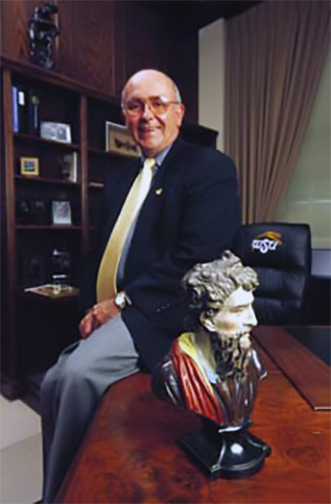
moved into his Morrison Hall office last year, he found
an unexpected connection to the university’s first
president, a vividly colored bust of Plato.
When Wichita State University’s 12th president, Dr. Donald C. Beggs, moved into his Morrison Hall office last year, he inherited, like all his predecessors save the first, certain keepsakes, certain remembrances left behind from those who had come before.
One of these items in particular captured President Beggs’ attention: a bust of Plato. Where had it come from? Why was it there?
As he picked it up to examine, he discovered two clues about its history. There were two typed notes attached to the piece, one — yellowed with age — taped to the back and another, much whiter, attached to the bottom of the base.
The whiter note reads, “Gift to Dr. Harry Corbin by Dean [Lambertus] Hekhuis of the College of LAS (a friend and favored mentor). The bust was on display in Dr. Corbin’s office in Jardine until he moved from it at which time he took it home for safekeeping.
Dr. Corbin requested that upon his death the bust be returned to the President’s Office.” And the other: “This bust of Plato belonged to President N.J. Morrison, the first president of Fairmount College. It was kept on President Morrison’s desk in his office during the years of his service at Fairmount.”
Despite the explanatory notes, to date no one has been able to uncover further information about the bust. It is not mentioned in an exhaustive inventory of items transferred in 1926 from Fairmount to the Municipal University of Wichita.
It is not to be found in photographs archived in Ablah Library’s special collections. And it is not mentioned anywhere in the index to The Sunflower. Notwithstanding its hazy history, this bust of Plato — itself surely as solid a symbol of the power of higher education than any one could ever hope to find — provides WSU’s present a tangible link to its past and its first leader, Nathan Jackson Morrison.
Even though Morrison was in his late 60s and in semi-retirement at Marietta College in Ohio, when Fairmount’s trustees were looking for a president to head their fledgling college in the summer of 1895, he accepted the challenge.
He was an experienced builder of colleges, namely of Olivet and Drury. And he had the contacts in the Eastern business community so necessary for new institutions on the frontier. A product of the 19th century New England liberal arts colleges, he was a firm believer that the classics should be the cornerstone of a college education.
Yet he also understood that Fairmount was a part of a unique community with specific needs. Consequently, he was a leader in the movement to emphasize the laboratory sciences of chemistry, physics and biology, and the initial curriculum also included art, music and teacher preparation.
He realized, too, that at least a third of the college’s graduates entered the business community, and Fairmount added “commercial” courses.
President Morrison was fond of quoting the Massachusetts Bay Chronicle of 1643 which stated, “One of the first things we longed for and looked after was to advance learning and perpetuate it among our posterity.” Fairmount College-Wichita State University, with President Beggs’ leadership and Plato’s surveillance, continues to pursue this goal.





